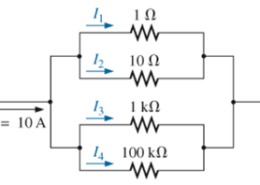Share
Parts (A) through (E) of this problem should be done by inspection—that is, mentally. The intent is to obtain an approximate solution without a lengthy series of calculations. For the network in figure:
ReportQuestion
Please briefly explain why you feel this question should be reported.
- What is the approximate value of I1, considering the magnitude of the parallel elements?
- What is the ratio I1/I2? Based on the result of part (a), what is an approximate value of I2?
- What is the ratio I1/I3? Based on the result, what is an approximate value of I3?
- What is the ratio I1/I4? Based on the result, what is an approximate value of I4?
- What is the effect of the parallel 100 kΩ resistor on the above calculations? How much smaller will the current I4 be than the current I1?
- Calculate the current through the 1 KΩ resistor using the current divider rule. How does it compare to the result of part (a)?
- Calculate the current through the 10 Ω resistor. How does it compare to the result of part (b)?
- Calculate the current through the 1 Ω resistor. How does it compare to the result of part (c)?
- Calculate the current through the 100 kΩ resistor. How does it compare to the solutions to part (e)?

Leave an answer